<< Previous | Displaying results 4081-4090 of 6776 for "" | Next >>
This photograph shows some of the 190 granite blocks donated to the United States Holocaust Memorial Museum by the Mauthausen Public Memorial in Austria. The Nazis established the Mauthausen concentration camp in 1938 near an abandoned stone quarry. Prisoners were forced to carry these granite blocks up more than 180 steps. The small blocks weighed between 30 and 45 pounds each. The larger blocks could each weigh more than 75 pounds. Prisoners assigned to forced labor in the camp quarry were quickly worked…
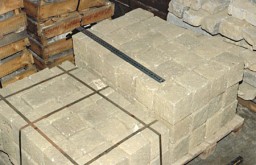
This casting of a gas chamber door in the Majdanek camp, near Lublin, Poland, was commissioned by the United States Holocaust Memorial Museum. Each gas chamber in Majdanek was fitted with an airtight metal door and was bolted shut before gas entered the chamber inside. SS guards could observe the killing process through peepholes in the upper center of the door.
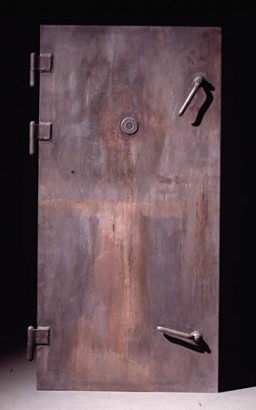
This taffeta and cotton skirt dates from the 1920s. It belonged to a Romani (Gypsy) woman who was born in Frankfurt, Germany, and who lived in Germany before the war. She was arrested by the Nazis and interned in the Auschwitz, Ravensbrück, Mauthausen, and Bergen-Belsen camps. She died in Bergen-Belsen in March 1945, shortly before the camp's liberation. Her husband and two of her six children were also killed in the camps.
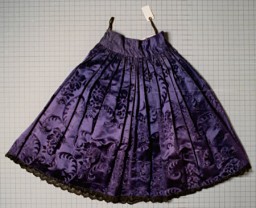
Set of tefillin in an embroidered bag. Tefillin are ritual objects worn by religious Jews during weekday morning prayers. This set was found on the body of a death march victim, who was buried near Regensburg, Germany.
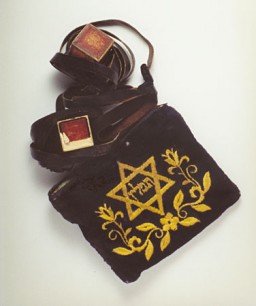
Soviet forces liberated the Sachsenhausen concentration camp in April 1945. In the camp, Soviet soldiers found this German edition of the Old and New Testaments on a dead prisoner, a Jehovah's Witness. The bible was sent to the prisoner's surviving family members.
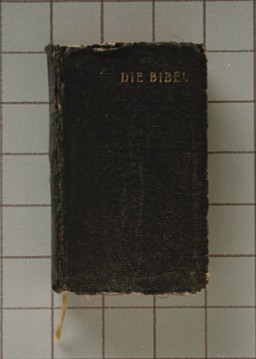
During the war the Japanese flooded Shanghai with anti-American and anti-British propaganda, including this image from a matchbox cover. It depicts a Japanese plane dropping a bomb on the U.S. and British flags. Shanghai, China, between 1943 and 1945. [From the USHMM special exhibition Flight and Rescue.]
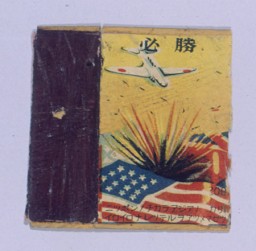
During the war the Japanese flooded Shanghai with anti-American and anti-British propaganda, including this image from a matchbox cover. It depicts Japanese planes flying in formation over the U.S. and British flags, with the Japanese flag rising in triumph. Shanghai, China, between 1943 and 1945. [From the USHMM special exhibition Flight and Rescue.]
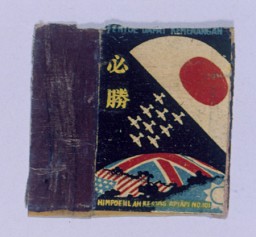
During the war the Japanese flooded Shanghai with anti-American and anti-British propaganda, including this image from a matchbox cover. It depicts a Japanese tank rolling over the U.S. and British flags. Shanghai, China, between 1943 and 1945. [From the USHMM special exhibition Flight and Rescue.]
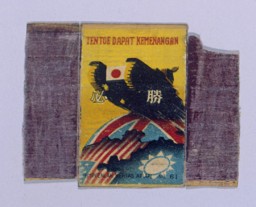
During the war the Japanese flooded Shanghai with anti-American and anti-British propaganda, including this image from a matchbox cover. It depicts United States President Franklin D. Roosevelt--dressed in rags, on a raft in the ocean, and holding onto the U.S. flag--in the view of a Japanese submarine periscope. Shanghai, China, between 1943 and 1945. [From the USHMM special exhibition Flight and Rescue.]
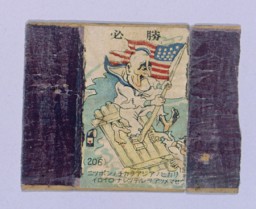
During the war the Japanese flooded Shanghai with anti-American and anti-British propaganda, including this image from a matchbox cover. It depicts a Japanese bomb landing in the United States heartland and knocking the stars off the U.S. flag. Shanghai, China, between 1943 and 1945. [From the USHMM special exhibition Flight and Rescue.]
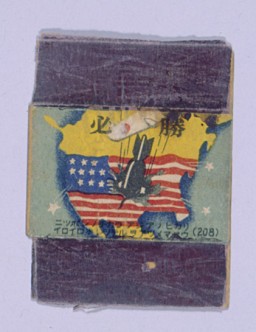
We would like to thank Crown Family Philanthropies, Abe and Ida Cooper Foundation, the Claims Conference, EVZ, and BMF for supporting the ongoing work to create content and resources for the Holocaust Encyclopedia. View the list of donor acknowledgement.